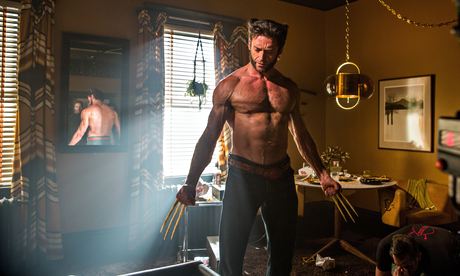
The latest instalment in this sector of Marvel's comic-book empire is a film of two halves. It takes place in two different eras, which means two different teams of superheroes battling to save humanity in their own ways, and two different casts: the Patrick Stewart/Ian McKellen gang from the first bunch of X-Men movies, and the younger generation, led byJames McAvoy and Michael Fassbender, from 2011's X-Men: First Class.
Unfortunately, it's a matter of two halves for the audience, too. If you've consulted your ring-binder of data from the previous six X-Men movies, you'll probably enjoy this. If you come to it fresh, it can be like trying to follow two games of chess at once.
The story involves time travel. The "classic" McKellen/Stewart X-Men are in some dystopian future where virtually everyone has been killed by indestructible robots called Sentinels. As a last resort, they send Wolverine, Hugh Jackman's alpha X-Man (right), back to the 1970s, Terminator-style. He must prevent a future apocalypse by foiling the Sentinels' inventor (Peter Dinklage, sadly kept on a tight rein compared with Game Of Thrones).
For the plan to work, Jackman must unite McAvoy and Fassbender – respectively the psychic Martin Luther King and metal-bending Malcolm X of the mutant struggle. Having fallen out in the previous X-Men movie, McAvoy is now a disillusioned addict and Fassbender is in a secure prison 100 floors beneath the Pentagon. Keeping up so far?
Most of the action takes place in this parallel 1970s, which means allusions to Vietnam, a cameo for Nixon and a wardrobe borrowed from American Hustle. Jennifer Lawrence's involvement confuses matters further. She's key to the success of the mission, but despite being able to alter her appearance however she wishes, she's obliged to spend most of the film prancing around virtually naked save for blue body paint.
Non-devotees might well give up, but director Bryan Singer always has a neat special effect, a well-timed gag or an action set piece around the corner, whipping up the action towards a symphonic climax.
For me, one unforgivable feature was the appearance, and rapid disappearance, of Quicksilver – an amiably nonchalant teen with the power to move so fast everyone else practically becomes a statue. The highlight of the movie is a scene where Quicksilver whizzes round altering the trajectories of enemy bullets hanging in the air, effectively getting everyone out of trouble without even removing his headphones. It's a visual and comic delight. It's also, in this Top Trumps world, a pretty handy superpower to have when you've got a world to save, you'd have thought. But inexplicably, the other X-Men just send him home early. Why? Perhaps because Quicksilver is also scheduled to appear in the next Avengers movie, another Marvel franchise being made by a different studio to X-Men.
These superheroes might be able to transcend the laws of nature but the logic of the franchise proves to be immutable, even if it means spoiling the audience's fun. For all its ambitious plotting, this X-Men is really an effective merger of the franchise's two separate incarnations, resolving one and continuing the other on its way towards the next summer blockbuster in 2016 – assuming there's still an appetite for it.
No comments:
Post a Comment